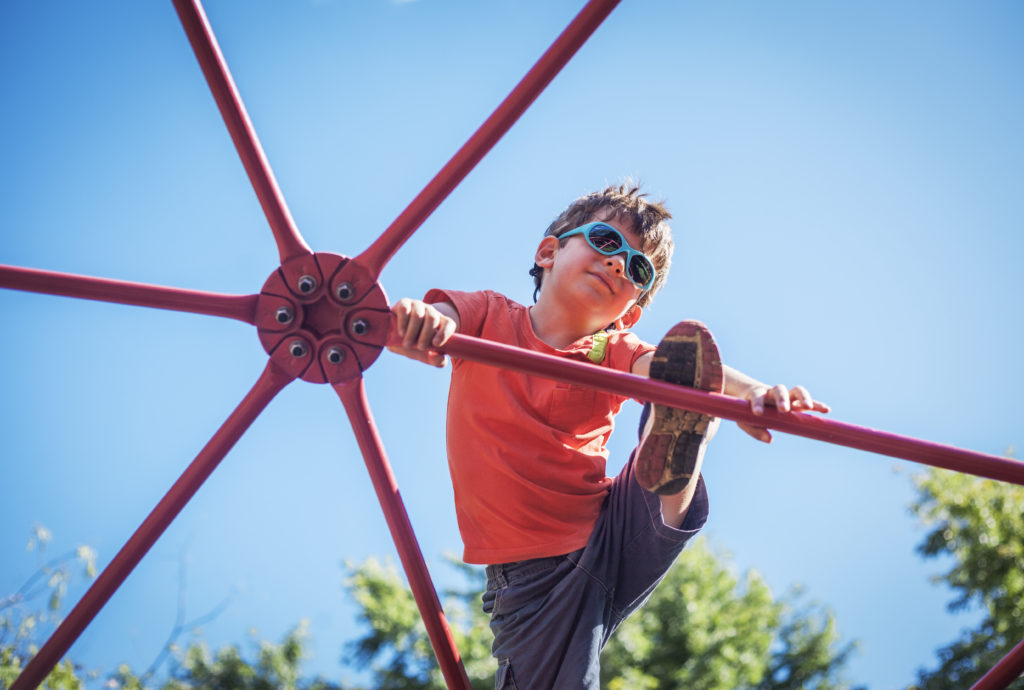Sunglasses for Children
Think only grown-ups need high-quality sunglasses? Think again.
Too much sun can significantly increase a person’s risk of cataracts, macular degeneration and other eye problems later in life. This risk depends on one’s cumulative exposure to sunlight over a lifetime. The best way to protect a person’s eyes from radiation damage is to begin dispensing high-quality sunglasses for children at an early age. This is true even if they don’t need prescription eyeglasses.

Children’s Eyes and UV
High-quality sunglasses are even more important for kids than they are for adults. Why? Children usually spend significantly more time outdoors than adults, increasing their exposure to ultraviolet (UV) and other solar radiation. According to the Skin Cancer Foundation, it is estimated that 23% of lifetime exposure to UV occurs by age 18. Other researchers say nearly half of a person’s lifetime UV exposure occurs by age 18.
Also, children have large pupils and the lens of a child’s eye does not filter UV and high-energy visible (HEV) light as effectively as an adult lens. These factors allow more harmful rays to penetrate deep into the eye during childhood. Unfortunately, many parents remain unaware of the importance of sunglasses for children. According to a 2012 Vision Council survey, 74 percent of American adults said they wear sunglasses for UV protection, but only 58 percent require their children to wear them. Read the full report here
Sunglasses for Kids: Recommended Features
100 Percent UV Protection
There are two types of ultraviolet rays from sunlight that can damage eyes: UVA and UVB. UVA is lower energy radiation, but it can penetrate deep into the eye. UVB has higher energy, but affects only the surface of the eye. For adequate eye protection, sunglasses for children should block 100 percent UVA and UVB.
HEV Protection
Like UVA, high-energy visible (HEV) light can penetrate deep into the eye and increase the risk of retinal damage. HEV is also called “blue light” because it is composed of short-wavelength (380 to 500 nm) visible light that comprises the blue and violet end of the visible light spectrum. Brown or amber-colored sunglass tints usually block HEV light more effectively than other shades. Sunglasses for kids should block as much HEV as possible.
Impact-Resistant Lenses
Generally, polycarbonate lenses are recommended for children’s sunglasses. These lenses automatically block 100 percent UV without the need for special lens coatings, tints or treatments.
“Poly” lenses also are lighter than regular plastic lenses and provide up to 10 times more impact resistance for greater comfort and eye safety during sports and active play.
A Comfortable Tint
UV rays are invisible, and dark sunglasses don’t necessarily provide more UV protection than lenses with lighter tints (or even no tint at all!). As long as the lenses block 100 percent UV and significant HEV, the color and density of the lens tint are a matter of personal preference.

A Durable, Close-Fitting Frame
For outdoor sports, the best option is a separate pair of sunglasses that feature a comfortable and durable “sport” frame. The best-fitting sport frames are adequately sized to provide a wide field of view and cover the eyes fully. The frame also should fit relatively close to the face to shield the eyes from dust and debris and decrease
the risk of the eyewear getting knocked off during sports and active play.
When To Wear
Be aware that clouds don’t block the sun’s UV rays. So it’s just as important for kids to wear UV-protective sunglasses on partly cloudy and hazy days as on days of full sun.
Offer Them The Best Protection Under The Sun
With 2x the Solar Blue Light Protection of the nearest competitor and 100% UVA and UVB protection, Coppertone Polarized Lenses offer a level of health protection that competitive brands simply cannot match. Learn more about Coppertone Polarized Lenses

 Read More
Read More
Your Eyes Burn Just Like Your Skin
Most people are still unaware that the dangers of sunlight apply not only to their skin – but to their eyes as well. Overtime the sun’s harmful rays can damage the eyes and surrounding skin contributing to serious eye problems like vision loss, macular degeneration and eyelid cancers. Continue reading…

